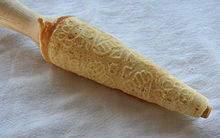Hip mass
Hippe masses are spreadable mass , which in the confectionery or bakery for the production of wafer rolls , ice cream cones , coupes, cornets, cups, rolls, " chimney sweepers ", flowers and other decorative articles used.
species
- Real hip mass (marzipan stick mass ) consists of marzipan raw mass , powdered sugar , wheat flour , milk or cream
- False hip mass (whole egg hip mass) consists of whole eggs, powdered sugar and wheat flour
- Egg whites are made from egg whites, sugar, wheat flour and grated almonds or hazelnuts.
Manufacturing
The ingredients are processed into a smooth, pliable mass. Then add flour and milk / cream. The mixture is stirred carefully and must not be beaten, because the air blown in causes unwanted bubbles and stains during baking. Hip mass can be kept cool for several days so that it can be prepared in advance.
After spreading in stencils on lightly greased trays or a silicone mat, baking takes place in two phases. First the mass is baked until it no longer shines and sticks. After cooling, it is baked until it is evenly golden brown.
After baking, the baked goods are soft and are molded hot, e.g. B. with a cornet wood. After cooling, the mass solidifies and turns into a splintery pastry.
Influence of raw materials
- Sugar makes the pastry brittle and the crunchy bite. Icing sugar is to be preferred because granulated sugar is difficult to dissolve, so the mass has to rest for a day.
- Egg white ensures the necessary binding. If only egg white is used, the baked goods will be brittle and hard. During baking, the high water loss causes the baked goods to form bubbles due to the formation of water vapor and lead to a non-uniform color.
- Flour ensures cohesion, which means that the necessary elasticity is available when molding.
- Milk / cream provides the necessary liquid for glue formation. The mass becomes soft and easily malleable.
The hip mass is seasoned with vanilla, cinnamon, arrack , lemon or sweet wine. Flavoring and coloring with cocoa powder is also common.
Individual evidence
- ↑ a b Friedrich Holtz u. a .: Textbook of the pastry shop . 5th edition. Trauner, Linz 2009, ISBN 978-3-85499-367-4 , pp. 323 ff .
- ^ IREKS Arkady Institute for Bakery Science (ed.): IREKS ABC of the bakery. 4th edition. Institute for Bakery Science, Kulmbach 1985
